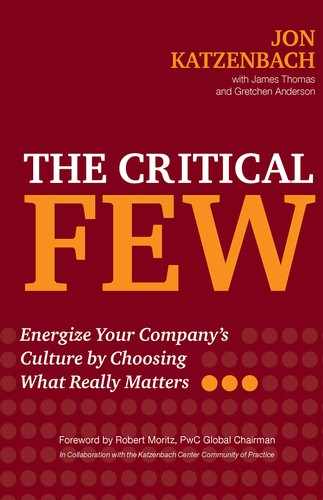Bibliography
This list does not aspire to provide a comprehensive overview of the field of writings on organizational culture. Instead, we have chosen to highlight some of the works (including, rather immodestly, Katz’s own) that either are referenced in the text of The Critical Few or are most salient to the core concepts of our methodology. We hope you’ll find these resources helpful.
Duhigg, Charles. The Power of Habit: Why We Do What We Do in Life and Business. New York: Random House, 2012.
Duhigg’s best-selling book explores the science behind habit formation and how to use that knowledge to change habits. Duhigg’s idea of “keystone habits” that can trigger other habits in individuals and their peers correlates to how powerful we believe the critical few behaviors can be to organization-wide transformations.
Goleman, Daniel. Emotional Intelligence: Why It Can Matter More than IQ. New York: Bantam Books, 1995.
Goleman’s influential book discusses the importance of the emotional mind (versus the rational mind) in human interaction. He describes the five crucial components of emotional intelligence—self-awareness, self-regulation, internal motivation, empathy, and social skills—and how they can be learned. The focus of Katz’s life work has been to harness sources of emotional energy within organizations to meet strategic goals.
Herzberg, Frederick. “One More Time: How Do You Motivate Employees?” Harvard Business Review, 1968. Reprint, Harvard Business Review (January 2003): 87–96.
Herzberg’s article analyzes the differences between factors that lead to employee engagement and those that lead to dissatisfaction. Herzberg was one of the first to argue that employee dissatisfaction cannot be addressed solely through “formal” factors such as company policy and compensation; motivation must stem from factors intrinsic to the work itself and recognition from others for achievement. What makes both a pride builder and an authentic informal leader is the ability to motivate others in the manner that Herzberg describes.
Katzenbach, Jon R. Why Pride Matters More Than Money: The Power of the World’s Greatest Motivational Force. New York: Crown Business, 2003.
Every company has unique sources of pride, and uncovering these sources is a critical part of understanding the existing culture as well as selecting the right “critical behaviors” that drive performance. The idea of an emotion as the primary driver of human performance that Katz introduces in Why Pride Matters is fundamental to The Critical Few.
Katzenbach, Jon R., and Zia Khan. Leading outside the Lines: How to Mobilize the Informal Organization, Energize Your Team, and Get Better Results. New Jersey: Wiley, 2010.
The premise of this book—that the best companies manage a sort of ambidexterity that balances the “formal” and “informal”—echoes the idea in The Critical Few that emotional and rational forces within an organization must align for superior performance. The book posits the “informal organization” as the network of emerging ideas, social networks, working norms, values, peer relationships, and communities of common interest that drive how people behave.
Katzenbach, Jon R., and Douglas K. Smith. The Wisdom of Teams: Creating the High-Performance Organization. Boston: Harvard University Press, 1993.
Katz’s first major book, rereleased in 2015, makes the core argument that there is no one ideal structure for teams. The strongest teams are those that can flexibly adapt their working styles in response to the challenges at hand. Katz now believes that this early work, as influential as it has been, misses a central point— that an individual team’s capability reflects not just its members’ own choices but the ecosystem of the organizational culture that surrounds them. However, The Wisdom of Teams’ argument that every team contains within it the ability to become “high performing” presages a fundamental idea in The Critical Few.
Katzenbach, Jon R., Ilona Steffen, and Caroline Kronley. “Cultural Change That Sticks,” Harvard Business Review (July–August 2012).
This article was early in making the point that if leaders want to evolve their culture, it’s better to work within that culture than fight it. The authors point out that enterprises attaining peak performance get there by applying five principles: match strategy and culture, focus on a few critical shifts in behavior, honor the strengths of your existing culture, integrate formal and informal interventions, and measure and monitor cultural evolution. Such companies see culture as a competitive advantage—an accelerator of change, not an impediment.
Leinwand, Paul, and Cesare Mainardi, with Art Kleiner. Strategy That Works: How Winning Companies Close the Strategy-to-Execution Gap. Boston: Harvard Business Review Press, 2016.
Executives today often grapple with closing the gap between strategy and execution. In Strategy That Works, the authors explore common pitfalls and demonstrate how some of the best companies in the world consistently outperform others. The notion of “cohesion” between elements at the heart of this book is very similar to the idea of the dynamic tension between strategy, operating model, and culture that we posit in The Critical Few. The authors argue that “putting your culture to work” is one of the five acts of unconventional leadership common to the world’s best companies.
Schein, Edgar. Organizational Culture and Leadership. New Jersey: Jossey-Bass, 1985.
This classic is now in its fifth edition. Schein is considered the father of organizational culture, and this book serves as a primer on the topic. It discusses how cultures are formed, the role of culture in the management of organizational change, and the role of leadership in shaping and guiding culture. It is a foundational text for any reader interested in this topic.
